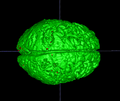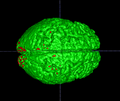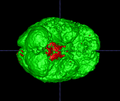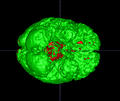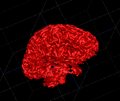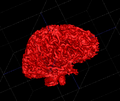2011 Winter Project Week:Extension of ABC to detect pathology categories
Key Investigators
- Utah: Bo Wang, Marcel Prastawa, Guido Gerig
- UCLA: Jack Van Horn, Andrei Irimia, Micah Chambers
Objective
Traumatic brain injury (TBI) occurs when an external force traumatically injures the brain. TBI is a major cause of death and disability worldwide, especially in children and young adults. TBI affects 1.4 million Americans annually. The UCLA medical school has been working on this topic for years.
On anatomical MRI scans, to quantitatively analyze the cortical thickness, white matter changes, we need to have a good segmentation on TBI images. However, for TBI data, standard automated image analysis methods are not robust with respect to the TBI-related changes in image contrast, changes in brain shape, cranial fractures, white matter fiber alterations, and other signatures of head injury.
We will work on an extension of ABC for TBI datasets with the clinical goal to investigate alterations in cortical thickness, subsequent ventricular, and white matter changes in patients with TBI.
Approach, Plan
ABC (Atlas-Based Classification) is a fully automatic segmentation method developed in Utah. It can process arbitrary number of channels/modalities by co-registration, it integrates brain stripping, bias correction and segmentation into one optimization framework. A brain atlas is used as spatial priors for tissue categories. We want to extend ABC to detect pathology categories, with tests on TBI images. In the first step, we want to add user interaction to the ABC framework.
After the project meeting, we will do the following work in the next step.
- Explanation of pathology (lesion, bleeding) for helping to design a better algorithm
- Development of semi-automatic supervised ABC module
Progress
During the project week, a lot of discussions have been done between the collaborators (UCLA and Utah groups) of this project. We worked together and answered each other's questions
The problems solved during the project week.
- Marcel introduced the purpose of all parameters and how these parameters would affect the final results.
- We discussed the possible user interaction we would use in the next step for better segmentation. We considered the following problems,
- provide the information the algorithm needed
- easy to understand and use
- avoid too much user interaction
- We knew more about the requirements of neurosurgeons and clinicians. They want to have the quantified measurement of changes.
- The limitation of number of channels, the maximum is five channels in Slicer now.
- standalone version of ABC is available
- Andrei pointed out the result of one subject was not good enough. Bo checked his results and redid the processing, and found the reason of the problem.


